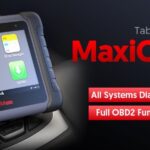A persistent “brake” warning light on your dashboard can be a significant cause for concern. While a simple visual check might not reveal any apparent issues, the problem often lies within the vehicle’s onboard diagnostic system, specifically the Obdii Brake Fault Codes. This guide delves into understanding these codes, their implications, and how to diagnose them effectively.
Decoding the Brake Warning Light
The red “brake” indicator illuminating on your instrument cluster signifies a potential problem within the braking system. It’s crucial to differentiate this from error messages displayed on the smaller orange screen, as the red warning typically points to a more immediate concern. While a pre-purchase inspection (PPI) might give a clean bill of health to the physical braking components, a lingering fault code could indicate an underlying issue.
The Role of the Handbrake Warning Switch
One common culprit behind the persistent brake warning light is the handbrake warning switch (S31a). This switch, located within the handbrake mechanism, sends a ground signal to the Junction Box Electronics (JBE) module when the handbrake is engaged. A malfunctioning switch or a fault in its wiring can trigger the warning light even when the handbrake is disengaged. The image below illustrates the wiring diagram for the handbrake warning light circuit:
This signal, transmitted through pin 13 of connector X14271 at the JBE, communicates with the instrument cluster (KOMBI), a control module (A2a) responsible for displaying various warning lights. Communication between the JBE and KOMBI occurs via a K-CAN BUS system, a network of six wires transmitting data between different modules.
Cruise Control Interaction
Interestingly, the handbrake warning switch also interacts with the cruise control system. A ground signal triggered by a faulty switch can inadvertently deactivate or prevent the engagement of cruise control. This connection acts as a fail-safe, ensuring the vehicle won’t maintain speed if a braking issue is detected. See the connection point X1682 in the diagram below:
Diagnosing with OBDII Scanners
Rather than relying solely on visual inspections or dealer diagnoses, utilizing an OBDII scanner can provide a more accurate assessment. These tools connect to the vehicle’s diagnostic port and retrieve specific fault codes stored within various modules, including the JBE, DSC (Dynamic Stability Control), and KOMBI.
These codes, accompanied by their definitions, pinpoint the exact location and nature of the fault. For example, a code related to the handbrake switch would confirm its malfunction, eliminating the need for guesswork. Furthermore, advanced scanners offer live data functionality, displaying the real-time status of various components, including the handbrake switch.
Conclusion: Empowering Car Owners with Knowledge
Understanding OBDII brake fault codes empowers car owners to take control of their vehicle’s maintenance and repairs. By utilizing readily available diagnostic tools and resources, drivers can accurately identify the root cause of brake warning lights, saving time and potentially avoiding unnecessary expenses. Accurate diagnosis is crucial for ensuring a safe and reliable driving experience, making the use of OBDII scanners an invaluable asset for any car owner.

